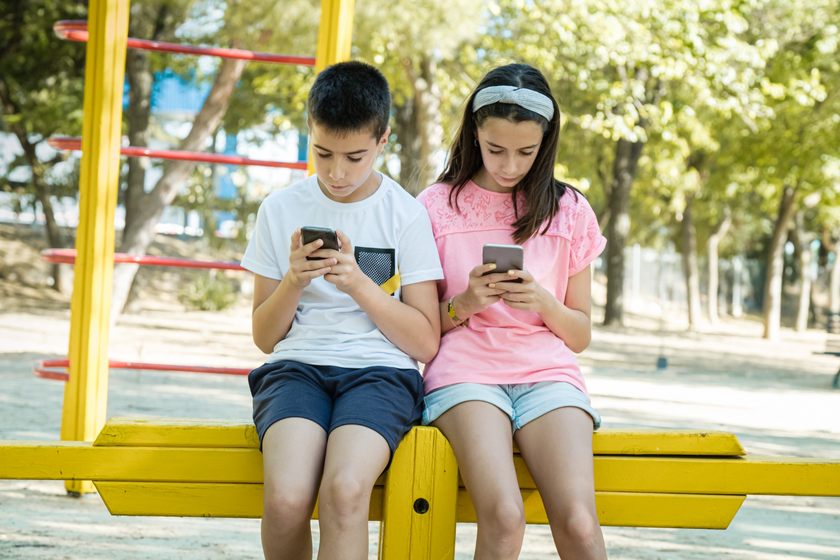
The amazing technology of social media can be a lifeline to friends and family who live across town—or on the other side of the planet! It’s a great way to keep in touch and share our lives with people we love. Everyone is just a scroll away—and so are their yummy meals, lush gardens and cute puppy pics! Adults and kids alike can find themselves procrastinating while browsing through the latest news. Like most good things, moderation is key when we’re using social media. Why does social media take a hold of our brains—even when we know we should put it down? And what can we about it?
Social Media Algorithm Addiction
If you’ve listened to or read just a bit of the news when controversies strike, you’ll know that social media companies put a lot of research and development into examining our habits while using their platforms. This is not all bad; anticipating what you like delivers more relevant content to your device! And of course, these platforms make all their money from advertisers who want to target people based on their habits. After all, social media is free to you…kinda. In exchange for your “free” account, your preferences and any other information you allow in your security settings are up for grabs.
Social media companies develop their format to keep you hooked and watching one thing after another (the reason for Reels on Facebook and the huge popularity of TikTok). The algorithms are developed to target the kinds of videos you like so that you watch longer and stay on their platform. This makes it more likely you’ll see their advertisers’ ads and they’ll be able to report to their clients how many eyeballs they’ve captured; this justifies their advertising rates. These algorithms are effective, in part, due taking advantage of how our brains work.
When your brain finds something stimulating, it creates a neurotransmitter called dopamine—this is the body’s reward system. So, when you get that boost of dopamine just by scrolling through videos, your brain and body don’t differentiate between that and the boost of dopamine you’d get if you won an award. Either way, your brain says, “This feels good!”
Social Media and the Dopamine High
So, what happens when we spend hours scrolling and viewing one video after the next? This creates a situation where we experience high levels of dopamine. The brain must make dopamine. It’s not just there, your body must make it, and there are several factors that contribute to this, including how well your genes are functioning to make the proper enzymes so that your body can make, store and degrade the proper neurotransmitters. Genes are just one factor. Your body must also utilize the right co-factors, the availability of which are influenced by nutrition. (Please read our previous article, What Role Do Genes Play in ADHD?, to understand this in greater detail.) When an activity bathes your brain in dopamine, it’s hard to tear yourself away and this creates an addiction that’s hard to put down. It also interferes with other activities.
For example, when kids’ brains make and use up a lot of dopamine during a stimulating social media activity and then attempt to switch to homework, it’s a non-starter. The brain may be unable to sustain the dopamine needed to focus on studies. This can result in kids getting behind in their schoolwork. They have a hard time putting down the social media—forming a feeling of addiction to this dopamine high and it becomes a challenge to redirect them when Mom and Dad place restrictions on the use of their devices.
Unfortunately, parental regulation of social media can become a never-ending loop of taking social media away, which improves behavior, then allowing it back in, which makes behavior suffer once again. Parents understandably hate to “punish” their kids in this way—there is incredible peer pressure for kids to interact with their friends on these platforms.
It may not be fair, but not everyone has the same physiological makeup; therefore, each person’s physical and mental reaction to indulging in social media will not be the same. Some people are naturally lower on the dopamine scale than others; therefore, they’re looking for those big boosts of dopamine for little effort.
Can We Really Put Down Social Media?
Social media tends to let us “off the hook” when it comes to physically doing something that we may be a little scared of or procrastinating about. Changing a profile picture may feel like an accomplishment because it dings that dopamine bell. It is the way our brain is wired. In addition, our brains evolved to ensure our security and self-preservation. Taking risks is something the brain naturally guides us away from. If you can ding your dopamine bell without much effort or risk, that makes your brain happy.
Beyond the addiction factor, consider that being glued to your phone and/or social media has become a way of life. Maybe it’s time we all think about actively engaging with our families instead of sitting literally feet away but engrossed in our separate devices. If it becomes more normal to be in the moment, then those that are more inclined to become “addicted” to social media because of their physiological makeup won’t feel so deprived. We’re all looking for dopamine to feel good at some level, so disentangling from our devices may just accomplish two goals: feeling happier and being more productive.
Tips for Parents: Healthy Use of Social Media
Parents may realize their kids can focus just fine when looking at their devices, because of the high levels of dopamine in those moments, but they’re not going to have any dopamine left to concentrate on their schoolwork. It’s a relief to know it’s not a question of intelligence, but maybe a habit that can be adjusted. Supplements and medications can attempt to replace the dopamine, but it’s less expensive and there are no side effects to just alter behaviors.
- Make sure that any app that your child has is age appropriate, and appropriate for your child in particular.
- Put time restrictions on social media use that are set in stone, even on the weekends.
- Get your kids outside.
- Find activities for your kids to enjoy, whether it’s sports or the science museum. Organized activities give them a way to make friends and engage with them in person.
- Let your kids be bored so that they must use their imaginations and find ways to entertain themselves. We did it when we were kids.
Technology is awesome. We can still use all the fascinating inventions that have made life easier, safer and more productive without letting them erode our communication skills and overall health. Our lifestyles may be a little lopsided in the direction of our screens, but with a few adjustments, we can fix that!

Special thanks to Dwight Franklin, Doctor of Oriental Medicine, for his help with this article. Dr. Franklin is the owner of Franklin Family Wellness Institute. He is a graduate of the Florida College of Integrative Medicine, where he received a master’s degree in Oriental Medicine and a bachelor’s degree in Health Studies. Over the course of his career, Dwight has worked alongside both pediatricians and psychiatrists in the treatment of ADD, ADHD, Autism, and various other common childhood and mental disorders through the practice of Oriental Medicine, Nutritional and Lifestyle changes, and Craniosacral Therapy. Call (407) 755-3135 or visit his website here: https://www.myffwi.com/
Top Image Copyright: 123rf.com/faustinocarmonaguerrero





